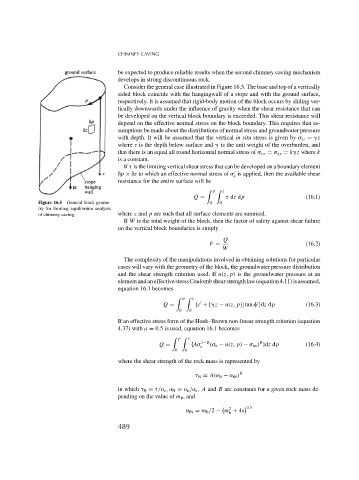Page 507 - Rock Mechanics For Underground Mining
P. 507
CHIMNEY CAVING
be expected to produce reliable results when the second chimney caving mechanism
develops in strong discontinuous rock.
Consider the general case illustrated in Figure 16.5. The base and top of a vertically
sided block coincide with the hangingwall of a stope and with the ground surface,
respectively. It is assumed that rigid-body motion of the block occurs by sliding ver-
tically downwards under the influence of gravity when the shear resistance that can
be developed on the vertical block boundary is exceeded. This shear resistance will
depend on the effective normal stress on the block boundary. This requires that as-
sumptions be made about the distributions of normal stress and groundwater pressure
with depth. It will be assumed that the vertical in situ stress is given by zz = z
where z is the depth below surface and is the unit weight of the overburden, and
that there is an equal all round horizontal normal stress of xx = yy = k z where k
is a constant.
If is the limiting vertical shear stress that can be developed on a boundary element
p × z to which an effective normal stress of is applied, then the available shear
n
resistance for the entire surface will be
% p % z
Q = dz dp (16.1)
Figure 16.5 General block geome- 0 0
try for limiting equilibrium analysis
of chimney caving. where z and p are such that all surface elements are summed.
If W is the total weight of the block, then the factor of safety against shear failure
on the vertical block boundaries is simply
Q
F = (16.2)
W
The complexity of the manipulations involved in obtaining solutions for particular
cases will vary with the geometry of the block, the groundwater pressure distribution
and the shear strength criterion used. If u(z, p) is the groundwater pressure at an
elementandaneffectivestressCoulombshearstrengthlaw(equation4.11)isassumed,
equation 16.1 becomes
% p % z
Q = {c + [ z − u(z, p)] tan }dz dp (16.3)
0 0
If an effective stress form of the Hoek–Brown non-linear strength criterion (equation
4.37) with a = 0.5 is used, equation 16.1 becomes
p z
% %
B
Q = {A 1−B ( n − u(z, p) − tm ) }dz dp (16.4)
c
0 0
where the shear strength of the rock mass is represented by
N = A( N − tN ) B
in which N = / c , N = n / c , A and B are constants for a given rock mass de-
pending on the value of m b , and
2 0.5
tN = m b /2 − m + 4s
b
489

